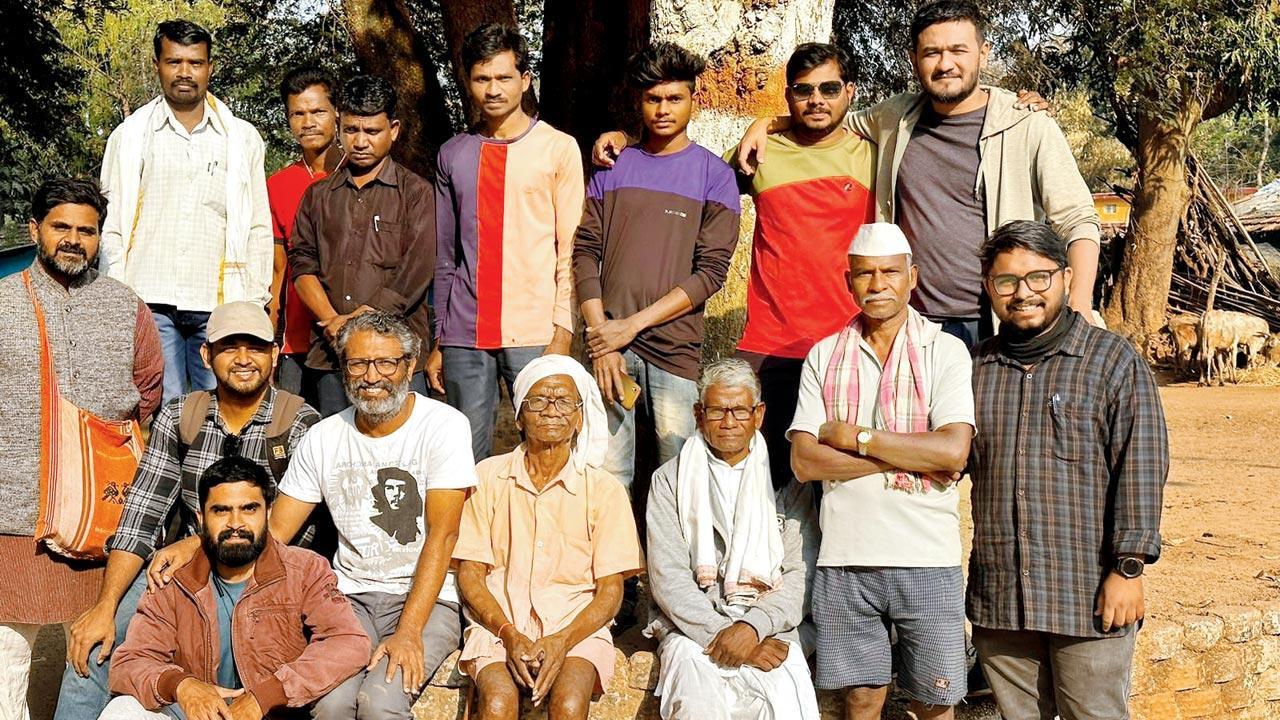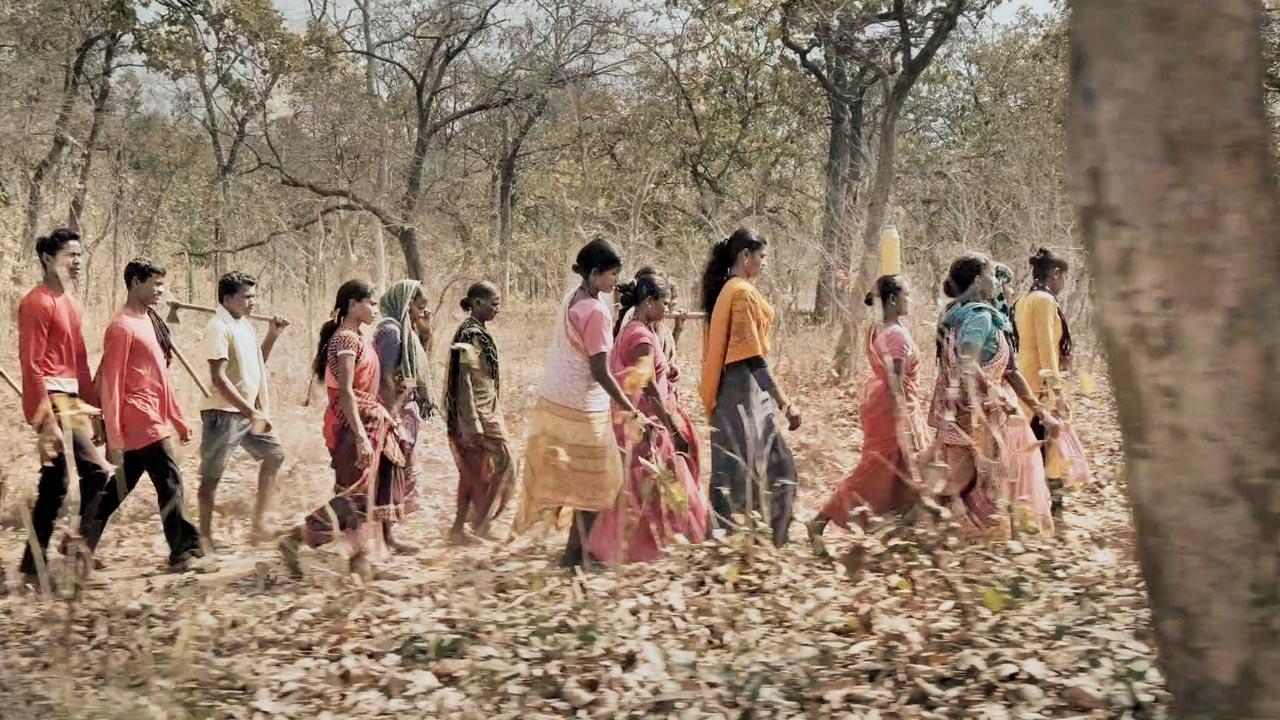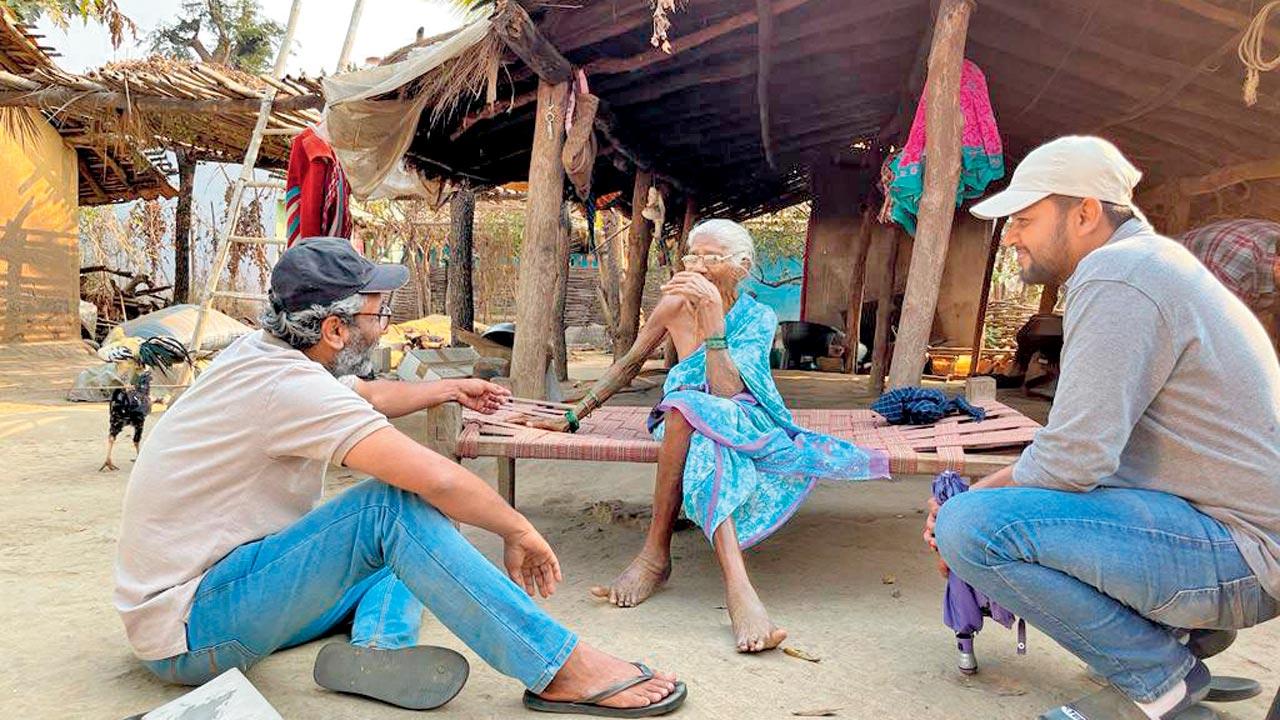A new documentary revisits Maharashtra’s Mendha Lekha village, which continues to offer lessons in self-rule, participatory democracy and forest conservation

Valsangkar (first row, fourth from left), cinematographer Ninad Gosavi (last row, first from right) along with Aditya Kashid (second unit camera), Atharva Gaiki, Shubham Parwekar (assistant directors) with Devaji Tofa, Dukku kaka and Mendha Lekha’s residents
![]() During the 33rd minute of Disha Swarajyachi’s hour-long runtime, a powerful maxim on screen seizes the viewer. It isn’t applicable solely to the experimentative Mendha Lekha village—the protagonist of the documentary; it rings true of every public agitation of the day, more so when the powers that be are inclined to disregard the view of the “other”.
During the 33rd minute of Disha Swarajyachi’s hour-long runtime, a powerful maxim on screen seizes the viewer. It isn’t applicable solely to the experimentative Mendha Lekha village—the protagonist of the documentary; it rings true of every public agitation of the day, more so when the powers that be are inclined to disregard the view of the “other”.
“Ladai karne ke liye, padhai karna padta hai; Bina padhai se ladai karenge toh haar bhi khayenge aur maar bhi khayenge (In order to wage a war, one must first study the situation; if we resist research and take up arms, we are bound to take a beating,” the maxim says. It is mouthed by Devaji Tofa, a Gond adivasi activist, as he looks back at Mendha Lekha’s Jungle Bachao, Manav Bachao journey since the 1980s. Tofa and the other celebrated agents of change in the village couldn’t have been more articulate about the importance of small, collective steps to bring in big-time reform.
ADVERTISEMENT
The recently released Marathi documentary Disha Swarajyachi (Towards Self Governance) evokes respect for the tribal individuals—mainly small landholders and subsistence farmers—who systematically and patiently lobbied for their right to take care of their 1,800-hectare forest and sell its produce, predominantly bamboo.
 A still from the film
A still from the film
In August 2009, Mendha Lekha became the first Indian village to secure community forest rights (CFR) under the historic piece of legislation, Forest Rights Act of December 2006. Earlier, forest areas were governed by the Indian Forest Act, 1927—a British-era law that empowered the government to unilaterally declare any area a “reserved/protected forest”. As per the older Act, no one except the State had rights to the forest’s produce. While forest areas are still governed by the Indian Forest Act, FRA, 2006 was enacted to redress the historic injustice meted out to tribals.
Mendha Lekha changed the very course of history. In a completely non-violent, activist stance, the village gram sabha successfully established its collective claim over the forest produce—be it bamboo, tendu leaves or moha flowers. In a consistent struggle lasting over two decades, which includes a study of legalities and Maharashtra’s bureaucracy, the 500 people-strong village declared that forest dwellers cannot be treated as encroachers in their inherited home; rather they are entitled to earn their livelihood by selling what the forest gives to them.
Taking inspiration from Acharya Vinoba Bhave’s “bhoodan” concept, Mendha Lekha became the first village to execute gramdaan, as hundred percent resident landowners surrendered their private ownership and voluntarily donated their land resources to the gram sabha. In fact, the village gramdaan could have received recognition immediately in 2013, but the government did not follow through on the three key measures of empowering a gramsabha—particularly the substitution of individual names on land records with that of the gramsabha. The village moved the Nagpur bench of the Bombay High Court as late as 2022 to get legal recognition of its gramdaan status, which the state government hadn’t granted! On Jan 21, 2024, the court directed the government to fulfill its duties or face contempt charges. While the journey is unending, the new documentary is a look-back at the milestones of the past, with an eye to the possibilities in the future.
 Valsangkar in conversation with Tarabai, a villager elder
Valsangkar in conversation with Tarabai, a villager elder
To director Virendra Valsangkar, 53, Mendha Lekha is not just a celebrated and known village with many firsts under its belt. He feels it shouldn’t be treated as a one-off, sunshine story. “It is a village that validates the new-age importance of swashasan (self-rule) because of the belief in certain community values inculcated by veterans like Devaji Tofa and Mohan Hirabai Hiralal who are embedded in Loknayak Jayprakash Narayan’s universal uplift philosophy.” He feels Mendha Lekha’s model of self-governance is often touted as a celebratory affair, but without acknowledging that it inspires the true participation of the “ordinary villager dwellers” in the Panchayat Raj structure.
The film shows the power of seemingly minor steps which beget big results—construction of the gotul (youth club centre), controlling liquor consumption in the village, formation of mohalla samitis, creation of hygienic common washrooms, and constituting abhyas mandals. A series of interviews—particularly those of the livewire women leaders—unfold the Panchayat’s building blocks and experiences. The interviews also bring in a good mix of insider and outsider voices: the sarpanch Nanda Dugga presents (literally) the view from the ground; Satish Gogulwar (founder of a non-profit aimed at building the capacities of communities) recounts the empowerment of 96 villages in the Korchi tehsil; Bhoodan movement scholar Parag Cholkar shows us where Mendha Lekha fits on the larger “swarajya” map.
Mendha Lekha is a rarity, an exception, but it is a goal that can be aspired to nonetheless, which is why Valsangkar did not name the film after the village. He wants to focus on other villages which do not have adivasi dwellers, but which have also shown the potential for reaching a consensus in the context of shared resources. In the documentary, Hiralal maintains very strongly that similar reform has taken place in the (non-adivasi) villages of Chandrapur district, such as Saigata (Brahmapuri taluka) and Pachgaon (Gondpipri). Many villages in Dhanora, Korchi and Kurkheda tehsils too have asserted their choice to self-govern; Some remote villages in Melghat have also exercised their rights to forest land. These villages have formed a federation, which signals a new step in participatory democracy. Hiralal feels observers from the so-called urban world attribute an easy rationale or theory to Mendha Lekha’s success—unity among tribals. However, the above examples show that non-tribal village clusters, heterogeneous in nature, are also awakening to matters pertaining to forest rights.
Mendha Lekha’s own story was first told to the world by sociologist-writer Dr Milind Bokil, who authored a book on the village in 2012. Its English translation, A Village Republic: The Story of Mendha Lekha, will soon be published by Orient BlackSwan. Bokil chronicled not just the citizen power in the village and its consequences, but he has also deeply invested in its trajectory over the years, which he articulates in Disha Swarajyachi. He was among the senior experts who encouraged the making of Valsangkar’s documentary.
Initially, when acclaimed filmmaker Sumitra Bhave was conducting research for a larger project on Gandhian experiments inspired by Vinoba Bhave, Dr Bokil provided his inputs detailing Mendha Lekha’s uniqueness. To witness the self-rule dynamic first-hand, Bhave lived in the village. At one point, after she shot the environs adequately, she asked Valsangkar (who worked as her assistant for many years and edited projects such as Devrai and Ha Bharat Maza) to edit the material into a film.
Since this footage was meant for research, Valsangkar felt the need to reshoot with the explicit purpose of making a film. But the world came to a halt when the COVID-19 pandemic struck, and the Mendha Lekha project took a backseat. When Valsangkar shot the village in March 2023, the pandemic subsided, but Bhave bid the world goodbye. “She opened the subject for me—it was an opportunity to see that the model was not a Utopia… Also that consensus is a matter of time—it has to be arrived at with effort,” the director explains.
Valsangkar has been making films for the past two decades, the most notable one being the biopic on Vishnupant Damle, a forgotten hero of Indian talkie cinema. He has worked closely with the Central Institute of Indian Languages, producing documentaries on Maharashtra’s forts, as well as special series on the Korku, Bhil and Warli tribes.
Mendha Lekha has been a subject of many documentaries and news media features for the last 25 years. Unsurprisingly, a new take on the makeup of the village unavoidably becomes a recap. Disha Swarajyachi is a well-meaning recap, notwithstanding the predictability in the montage of interviews and a slightly low-energy voiceover. It instills pride in Maharashtra’s Gadchiroli district, which is usually characterised by stories of tribal malnourishment. The village implemented representative and participatory democracy, much before the Indian Constitution’s 73rd Amendment (1992) compelled state governments to adopt the three-tier decentralised Panchayat Raj. Mendha Lekha is a golden chapter in the Indian civics textbook, a re-reading of which doesn’t hurt.
Sumedha Raikar-Mhatre is a culture columnist in search of the sub-text. You can reach her at sumedha.raikar@mid-day.com
 Subscribe today by clicking the link and stay updated with the latest news!" Click here!
Subscribe today by clicking the link and stay updated with the latest news!" Click here!








